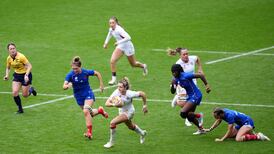Referees reported 26 suspected concussions in 425 matches during the 2014-15 Ulster Bank League (UBL), according to a memo from the IRFU to referees seen by The Irish Times. The figures were produced from a reporting system put in place by the union to enable referees to report concussions to the IRFU's medical department.
The data suggest a rate of 1.5 concussions per 1,000 hours (measuring per 1,000 player hours is the standard way to represent concussion incidence figures).
This compares with 8.5/1,000 hours in Irish professional rugby last season (42 concussions recorded by Irish teams in Pro12, Champions Cup and international games) and 10.5/1,000 hours by Aviva Premiership players in the 2013-14 club season. But the amateur and professional games are not the same.
"The numbers that you're talking about sit very closely to what we've reported," said Keith Stokes of the University of Bath, referring to a rate of 1.2 concussions recorded per 1,000 hours in the English community game (amateur and semi-professional) from 2009 to 2012. "But then you get into the discussion about how confident you are that those numbers are a genuine reflection about what's happening at that level of the game, or not."
Concussion figures also need context. The English community game figure was based on players kept off the field for a minimum of eight days. Roughly a third of Premiership concussions in 2013-14 saw the player show no further symptoms and return in six days. It’s important to know what was being counted when comparing raw numbers.
Injury mechanism
UBL referees who logged a suspected concussion used an online form to report basic information about the incident, including player’s name and number as well as the injury mechanism if known. The IRFU supplied a breakdown of those injury mechanism figures to
The Irish Times,
showing that ten of the 26 were unknown to the referee, possibly because the referee did not see the incident causing the impact.
The data from that system is crude, IRFU head of medical services Dr Rod McLoughlin told The Irish Times. "The figure of 1.5 that we have: you can't really say that this is true injury surveillance," he said.
He said they put the referee reporting system in place “to get some impression of the rate at the amateur level, at least in the short term, as well as showing that the IRFU was serious about its concussion policy”.
There were two incidents where the union followed up with coaches who had selected a player before they had completed the return-to-play period. The IRFU said that in each case the club confirmed the player involved had been medically reviewed and no diagnosis of concussion made.
McLoughlin has complete access to injury information for the Irish professional game where the four provincial setups, along with the national side, now all use the same Kitman Labs injury recording system. There isn’t the same level of data for the sub-elite level.
The England Professional Rugby Injury Surveillance Project has shown a significant increase in the rate of reported concussions in the elite game .
Awareness and educational improvements aside, it should not go unnoticed that 2011-12 marked a change in concussion protocols. The graduated return-to-play protocol enabled a team’s medical staff to declare a player fit to return to active playing duty after a minimum of six days as opposed to 21 (unless cleared by a neurological specialist).
While the incentive to withhold a concussion diagnosis certainly changed, there has been no causal link proven between the decrease in the minimum stand-down period and the increase in reported concussions. The UBL minimum absence for a concussed player is 21 days; 23 days for age-grade rugby.
There will likely always be an inherent difference between reported concussion rates in the amateur and professional games (factors: speed of play; magnitude and number of collisions; monitoring and medical expertise available). But both Stokes and McLoughlin expect the reported concussion rate in the amateur game to rise.
Changing attitude
“The awareness and understanding that we’re seeing now at the professional end of the game, both in terms of players, coaches and medical staff, that’s always going to take a little while to filter down to the community game,” said Stokes.
McLoughlin remembered his time as a doctor in the All-Ireland League, where “you had this thing of people putting pressure on you to say it was a hamstring or something, that it wasn’t a concussion”.
McLoughlin thinks this attitude is changing, with amateur players and coaches getting the message that along with any long-term health impact, a concussion can also affect performance on the field.
Getting more data can only help our understanding of sport’s invisible injury.











